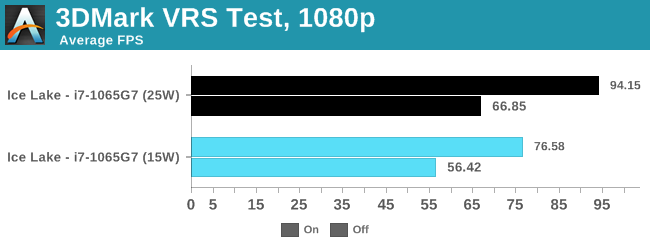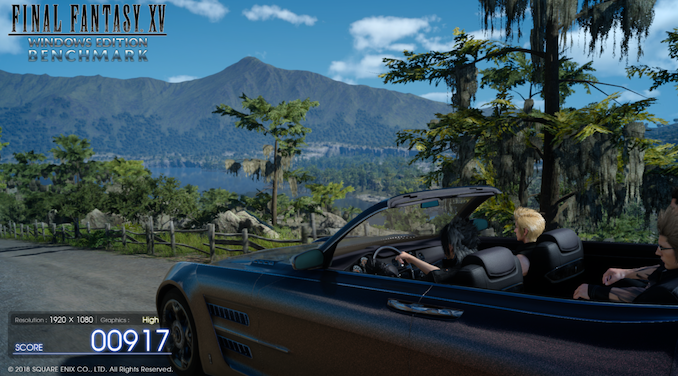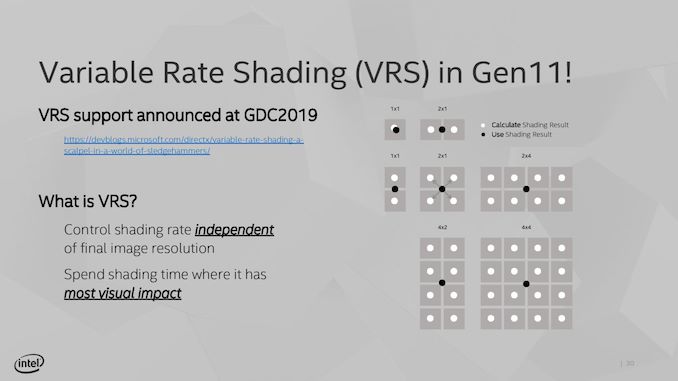The Ice Lake Benchmark Preview: Inside Intel's 10nm
by Dr. Ian Cutress on August 1, 2019 9:00 AM EST- Posted in
- CPUs
- Intel
- GPUs
- 10nm
- Core
- Ice Lake
- Cannon Lake
- Sunny Cove
- 10th Gen Core
Gaming Results (15W and 25W)
One of the biggest changes to the Ice Lake design is in the integrated graphics – Intel is now giving more focus and more die area to graphics, something it has arguably been neglecting for several years now. With Ice Lake, we move to a Gen11 graphics architecture, which is almost like the previous Gen9.5 but now with added support for variable rate shading (VRS), moving from 24 EUs to 64 EUs, and memory support up from LPDDR3-2133 to LPDDR4X-3733.


World of Tanks is a very CPU driven benchmark, and having the extra frequency of the 25W processor does help here. We're getting a sizeable uplift from Whiskey Lake, due to the extra EUs and memory frequency.


Our Final Fantasy test seemed to regress in 25W mode, although still within the noise. This test is still GPU bound, so adding the extra TDP to the CPU didn't actually help much. However, comparing to the Whiskey Lake integrated graphics, we've got over a 2x speedup.


Similarly with Civilization, with what is normally our 'IGP' settings, we are still GPU limited here.
One of Intel's newest features is Variable Rate Shading.
If developers add the option, soon to be an easy checkbox in Unity and Unreal, the game can decide to control the rate at which it shades pixels, from calculating every pixel down using one result across a 4x4 grid, to save compute power. Currently the only way to test this is with the 3DMark functional demo.

The new VRS test in 3DMark is designed as a feature test to show the potential uplift effect from enabling variable rate shading within a game. In both 15W and 25W modes, the data saw a good uplift, and we seemed to get more out of the 25W mode than the 15W mode.














261 Comments
View All Comments
jcc5169 - Thursday, August 1, 2019 - link
It's like a long running Intel advertisement ......Ian Cutress - Thursday, August 1, 2019 - link
How so?jordanclock - Thursday, August 1, 2019 - link
Probably because you provided objective measurements instead of long winded conjecture.peevee - Friday, August 2, 2019 - link
"As for Ice Lake itself, our results lean towards Ice Lake outperforming Whiskey Lake, if only by a small margin."A laptop allowing more than 50W on a U chip and with cooler always running is certainly not representative of the real world performance a user would get from real systems. If Whiskey Lake results were obtained on a real system, then the results are not comparable enough that Ice Lake can actually be slower, especially in real world loads (note the performance on x264 and POV-Ray essentially has not changed).
But at least iGPU has improved nicely.
Samus - Saturday, August 3, 2019 - link
They have dedicated pages to 15w and 25w results. Not sure what you're on about about 'allowing more than 50W...' when they power limited the chip for specific-scenario benchmark results.Spunjji - Monday, August 5, 2019 - link
You may want to re-read that Power Results section - put simply, peevee's point still stands and your response is mistaken. At the 25W limit, the CPU spent more than 20 seconds operating between 50W and 35W before it finally dropped down. It's unlikely that the Coffee / Whiskey devices they tested allowed that sort of behaviour, as without a continuous 100% fan speed the thermals would have spiked and lowered the power limit far sooner. Even with the "power limits" you're talking about in place, the chip still boosts like that, so their benchmark results incorporate that behaviour. for any other company I might feel generously inclined, but Intel have already pulled a fast one multiple times by releasing CPUs that have nominally higher specifications but never reach their performance potential in shipping designs due to thermal constraints.Gondalf - Wednesday, January 8, 2020 - link
Spec suite (the reference) is a pretty loooong bench so the cpu stay at 15W all the time without your 50W. Your comment say a lot about you.yeeeeman - Wednesday, June 17, 2020 - link
Also, we not comparing power efficiency here but rather IPC of each core. And the bottom line is that Sunny Cove core has 5-10% better IPC than Zen 2.CSMR - Sunday, August 4, 2019 - link
There is no evidence that the iGPU has improved. We'd need a comparison against Iris Plus 655 to confirm that. We only know EUs have increased (64 vs 48) but EDRAM was removed.brakdoo - Thursday, August 1, 2019 - link
"First of all, I must say that Intel offering us to test a reference system in advance of a launch is a very good thing indeed"You are being played once again as a marketing tool for the Ice Lake launch. Don't tell me you don't see that.